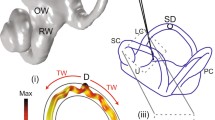Abstract
Since inner ear hair cells are mechano-electric transducers the control of hydrostatic pressure in the inner ear is crucial. Most studies analyzing dynamics and regulation of inner ear hydrostatic pressure performed pressure measurements in the cochlea. The present study is the first one reporting about absolute hydrostatic pressure values in the labyrinth. Hydrostatic pressure of the endolymphatic system was recorded in all three semicircular canals. Mean pressure values were 4.06 cmH2O ± 0.61 in the posterior, 3.36 cmH2O ± 0.94 in the anterior and 3.85 cmH2O ± 1.38 in the lateral semicircular canal. Overall hydrostatic pressure in the vestibular organ was 3.76 cmH2O ± 0.36. Endolymphatic hydrostatic pressure in all three semicircular canals is the same (p = 0.310). With regard to known endolymphatic pressure values in the cochlea from past studies vestibular pressure values are comparable to cochlear values. Until now it is not known whether the reuniens duct and the Bast’s valve which are the narrowest passages in the endolymphatic system are open or closed. Present data show that most likely the endolymphatic system is a functionally open entity.

Similar content being viewed by others
References
Düwel P, Jüngling E, Westhofen M, Lückhoff A (2003) Potassium currents in vestibular type II hair cells activated by hydrostatic pressure. Neuroscience 116:963–972
Wit HP, Feijen RA, Albers FW (2003) Cochlear aqueduct flow resistance is not constant during evoked inner ear pressure change in the guinea pig. Hear Res 175:190–199
Carlborg BI, Farmer JC (1983) Transmission of cerebrospinal fluid pressure via the cochlear aqueduct and endolymphatic sac. Am J Otolaryngol 4:273–282
Salt AN, Rask-Andersen H (2004) Responses of the endolymphatic sac to perilymphatic injections and withdrawals: evidence for the presence of a one-way valve. Hear Res 191:90–100
Warmerdam TJ, Schröder FH, Wit HP, Albers FW (1999) Perilymphatic and endolymphatic pressure in the normal guinea pig. ORL J Otorhinolaryngol Relat Spec 61:71–73
Feldman AM, Bittner RH, Brusilow SW (1979) Measurement of the hydrostatic pressures of the cochlear compartments. Neurol Res 1:11–18
Yoshida M, Lowry LD (1984) Hydrostatic pressure measurement of endolymph and perilymph in the guinea pig cochlea. Am J Otolaryngol 5:159–165
Long CH, Morizono T (1987) Hydrostatic pressure measurements of endolymph and perilymph in a guinea pig model of endolymphatic hydrops. Otolaryngol Head Neck Surg 96:83–95
Nakashima T, Watanabe Y, Yanagita N (1987) The effect of round window membrane puncture on endolymphatic and perilymphatic pressures. Arch Otorhinolaryngol 244:236–240
Böhmer A, Andrews JC (1989) Maintenance of hydrostatic pressure gradients in the membranous labyrinth. Arch Otorhinolaryngol 246:65–66
Andrews JC, Böhmer A, Hoffman LF (1991) The measurement and manipulation of intralabyrinthine pressure in experimental endolymphatic hydrops. Laryngoscope 101:661–668
Valk WL, Wit HP, Albers FW (2008) Changes in CMDP and DPOAE during acute increased inner ear pressure in the guinea pig. Eur Arch Otorhinolaryngol 265:287–292
Böhmer A (1993) Hydrostatic pressure in the inner ear fluid compartments and its effects on inner ear function. Acta Otolaryngol Suppl 507:3–24
Hott ME, Graham M, Bonassar LJ, Megerian CA (2003) Correlation between hearing loss and scala media area in guinea pigs with long-standing endolymphatic hydrops. Otol Neurotol 24:64–72
Valk WL, Wit HP, Albers FW (2006) Changes in distortion of two-tone cochlear microphonic and otoacoustic emission signals during an acute endolymphatic hydrops in the guinea pig. Eur Arch Otorhinolaryngol 263:430–434
Wada Y, Suzuki H, Watanabe S (1994) Changes of endolymphatic pressure in the semicircular canal of pigeon by caloric stimulation. Adv Space Res 14:385–388
Konishi S (1977) The ductus reuniens and utriculo-endolymphatic valve in the presence of endolymphatic hydrops in guinea-pigs. J Laryngol Otol 91:1033–1045
Bast TH (1928) The utriculo-endolymphatic valve. Anat Rec 40:61–65
Hofman R, Segenhout JM, Buytaert JAN, Dirckx JJJ, Wit HP (2008) Morphology and function of Bast’s valve: additional insight in its functioning using 3D-reconstruction. Eur Arch Otorhinolaryngol 265:153–157
Schuknecht HF, Belal AA (1975) The utriculo-endolymphatic valve: its functional significance. J Laryngol Otol 89:985–996
Bachor E, Karmody CS (1995) The utriculo-endolymphatic valve in pediatric temporal bones. Eur Arch Otorhinolaryngol 252:167–171
Takeuchi S, Takeda T, Saito H (1990) Pressure relationship between perilymph and endolymph in guinea pigs. Acta Otolaryngol 109:93–100
Yamauchi A, Rabbitt RD, Boyle R, Highstein SM (2002) Relationship between inner-ear fluid pressure and semicircular canal afferent nerve discharge. J Assoc Res Otolaryngol 3:26–44
Wit HP, Hofman R (2007) Does the endolymphatic sinus function as a one-way valve? Hear Res 224:115–116
Conflict of interest
None.
Author information
Authors and Affiliations
Corresponding author
Additional information
J.J.-H. Park and J.J. Boeven have contributed equally to this work.
Rights and permissions
About this article
Cite this article
Park, J.JH., Boeven, J.J., Vogel, S. et al. Hydrostatic fluid pressure in the vestibular organ of the guinea pig. Eur Arch Otorhinolaryngol 269, 1755–1758 (2012). https://doi.org/10.1007/s00405-011-1813-6
Received:
Accepted:
Published:
Issue Date:
DOI: https://doi.org/10.1007/s00405-011-1813-6



